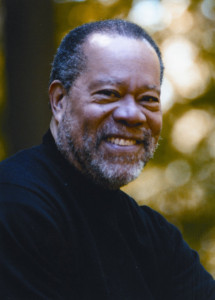Pinkney, Jerry
 Jerry Pinkney’s Art and Heart
Jerry Pinkney’s Art and Heart
Is there is a more beloved creator in the world of children’s books than Jerry Pinkney? He is the patriarch of a respected dynasty, he has brought favorite fables of childhood to contemporary children, and he is a tireless advocate for the power of the story.
Although Jerry Pinkney grew up in a family with a rich tradition of oral storytelling, he did not have easy access to a library or bookstore. “Storytelling was my library,” Jerry fondly recalls, “and became an important piece of the fabric of my world.” Hans Christian Andersen, Uncle Remus, and Aesop were favorites of his mother and those moments of wonder, humor, and mystery have revealed themselves again and again in her son’s work for the past 50 years.
“Aesop’s fables are a direct route back to my childhood,” explains Jerry. “I remember them so clearly.” Why does he enjoy them so much? “Part of their pull is that when I’m physically working on the art, I feel a presence of that time–I connect with my family and with my growing up years so it is a way of going back.” Most of all, those stories “fired up my imagination and I hope it will do the same for children today,” he says.
The first fable he remembers hearing was “The Lion and the Mouse.” Jerry notes that “Lions always capture our imaginations with their strength and magnificence.” He remarks that the story, with its underdog mouse, works in much the same way as with Hans Christian Andersen and “The Ugly Duckling”–“We can all identify with the ugly duckling and with the mouse, that no matter how small you are you can make an impact.” Another reason to focus on this particular story? “I love drawing lions.” The Lion and the Mouse was always first on his list.
Jerry Pinkney’s last entry in his Aesop trio is The Grasshopper and the Ants. “[Editor] Andrea Spooner asked me how I was going to make insects appealing and fun,” confides the artist. “That might have been one of the reasons why I kept that particular story at bay because in the beginning, I didn’t know how I was going to do that!”
The solution came about in his sketchbook, which he rarely uses to develop characters. Now, the artist often will “share those sketches with young children because they show the process of trying to personify these insects, of me trying to figure out if they should be wearing clothing, how that should look and so on.” The answer to the problem came about in the doing of it: “When I came to the conclusion that whatever they were wearing had to come from nature, that was the key.” Perhaps surprisingly, he now says that The Grasshopper and the Ants is “in many ways, of all the books that I’ve done, one of the more joyous in terms of discovery.” He then chuckles and adds, “I have to say, that’s because it worked!”
Jerry Pinkney’s trio of illustrated fables is now done and if there is a fourth, he says it will come back in a different way.
His next project, In Plain Sight, is by Dick Jackson, another towering figure in the children’s book world. Jerry comments that he hadn’t done figurative work in awhile and he found himself flexing different creative muscles as he worked out facial expressions and head movements. “It’s a challenge for me, by the way, because when I’m doing animals, there is something organic where I’m responding to something that I create, whereas with figurative work I’m responding to what the character should say.” The artist further articulates that “Those are two completely different ways of approaching my art and each requires something completely different from me.” Even after fifty years, Jerry Pinkney is still learning, which is one of the key reasons his works remains as fresh as ever.
With such a rich oeuvre, it’s not surprising that Jerry Pinkney’s work has often been featured in traveling art exhibits. “WITNESS: The Art of JERRY PINKNEY” was mounted by the Norman Rockwell Museum, a singularly appropriate setting for a distinguished illustrator. Most surprising to his children’s book fans would be the work he has done outside that world: Jerry’s art has appeared on magazine and album covers and he also did the first nine stamps in the National Postal Service’s black heritage series.
For Jerry Pinkney, “Part of my work all along has been to be a bridge to not only my childhood but also my hope for the future and especially for children and how they see the world.” “‘Witness’ was designed to be a bridge and was used by museums in an effort be more accessible to people of color,” notes the artist. “Witness” traveled the country for three years.
His newest exhibit is “Jerry Pinkney: Imaginings” which begins in Northampton, MA and, at press time, is being booked in various venues around the country including Greenville, SC. On the morning of our conversation, Jerry had just learned that a church had been burned down not far from where the exhibit is to take place. The news grieved him but he concluded that “The mission of my work has always been to bring hope and life and a sense that we all occupy the same space.”
We are all lucky that we occupy the same space as Jerry Pinkney.
Interviewed by Ellen Myrick, July 2015
Click here for titles available in the BTSB Bookstore from this author
